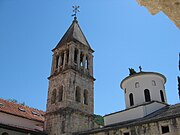Church of St. George, Bobota
| Church of St. George | |
|---|---|
| Crkva svetog Đorđa Црква светог Ђорђа | |
 Church of St. George | |
 | |
| 45°25′19″N 18°51′24″E / 45.42194°N 18.85667°E | |
| Location | Bobota |
| Country | Croatia |
| Denomination | Serbian Orthodox |
| History | |
| Dedication | St. George |
| Architecture | |
| Style | Baroque and Classicism |
| Administration | |
| Archdiocese | Eparchy of Osječko polje and Baranja |
The Church of St. George (Croatian: Crkva svetog Đorđa, Serbian Cyrillic: Црква светог Ђорђа) in Bobota is Serbian Orthodox church in eastern Croatia. The church is famous for its icons in the iconostasis that were painted in 1778.[1] During the Croatian War of Independence, administration of Eparchy of Osječko polje and Baranja sent the icons on the restoration[2] and preservation in Vojvodina.[1] The icons were returned to the church after the end of war.[3] The decision to remove the cultural property from the church caused controversy and was an open issue in Croatia–Serbia relations up until the final return of icons.
History
First Eastern Orthodox Christians in Bobota are mentioned in document from 1366 during the Kingdom of Hungary rule in the region.[4] 30 Serb households are mentioned in 1558 during the Ottoman Hungary period.[4] One older Serbian Orthodox church, mentioned in 1733, existed at the site of the present day church.[4] The decision to build a new one was made in 1762 when the Village Knez (petty nobility title) Jovan Nedeljković.[4] Until 1866 the village was organized into two Serbian Orthodox parishes with two priests with families living in Bobota.[4] Up until the beginning of the World War I the church tower had a 600 kilogram four rings built in Pest which were then confiscated by the Austro-Hungarian Army.[4] After the establishment of the Kingdom of Serbs, Croats and Slovenes new four rings of 1400 kilograms were made in Ljubljana.[4] During the World War II in Yugoslavia and the Genocide of Serbs in the Independent State of Croatia the church was converted into a Roman Catholic church.[4] At the final stage of the war in 1945, Yugoslav Partisans burned down the parish building which was next to the church. The new parish building was built in 1952 during the early years of the existence of the Socialist Republic of Croatia.
See also
- Eparchy of Osječko polje and Baranja
- Bobota
- Serbs of Croatia
- List of Serbian Orthodox churches in Croatia
References
- ^ a b "Pravoslavnoj crkvi u Boboti vraćene ikone - Vijesti.net". Index.hr (in Croatian). 21 December 2004. Retrieved 10 September 2012.
- ^ "Dobitnici nagrade Milorad Medić". Archived from the original on 29 November 2011. Retrieved 8 December 2011. (Danijela Korolija Crkvenjakov>Bibliografija>Elaborat o konzervaciji i restauraciji prestone zone ikonostasa srpske pravoslavne crkve u Boboti)
- ^ "Matica hrvatska – Povrat kulturnih dobara otuđenih iz Hrvatske". Matica.hr. 16 November 2001. Archived from the original on 13 March 2005. Retrieved 10 February 2012.
- ^ a b c d e f g h "Pravoslavni hramovi u Boboti i Bijelom Brdu". Srbi.hr, Joint Council of Municipalities. 20 April 2018. Retrieved 3 September 2021.
- CS1 Croatian-language sources (hr)
- Use dmy dates from September 2021
- Articles with short description
- Short description matches Wikidata
- Infobox mapframe without OSM relation ID on Wikidata
- Coordinates on Wikidata
- Articles containing Croatian-language text
- Articles containing Serbian-language text
- 18th-century Eastern Orthodox church buildings
- Serbian Orthodox churches in Vukovar-Syrmia County
- All stub articles
- Europe Eastern Orthodox church stubs
- Croatian building and structure stubs
- Pages using the Kartographer extension



